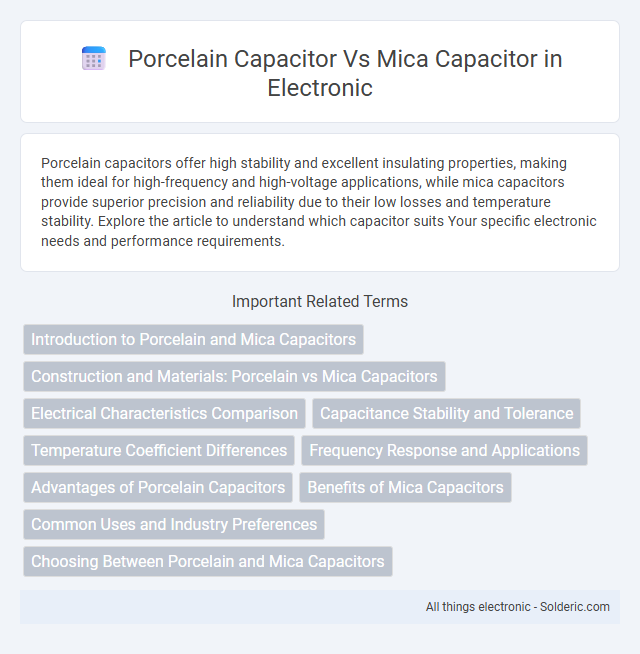Porcelain capacitors offer high stability and excellent insulating properties, making them ideal for high-frequency and high-voltage applications, while mica capacitors provide superior precision and reliability due to their low losses and temperature stability. Explore the article to understand which capacitor suits Your specific electronic needs and performance requirements.
Comparison Table
| Feature | Porcelain Capacitor | Mica Capacitor |
|---|---|---|
| Dielectric Material | Porcelain (ceramic material) | Mica (natural mineral) |
| Capacitance Range | Few pF to nF | Few pF to uF (typically up to 0.1uF) |
| Voltage Rating | Up to several kV | Up to several kV |
| Temperature Stability | Moderate to high | Excellent (+-1% or better) |
| Dielectric Loss (Dissipation Factor) | Moderate | Very low |
| Precision | Lower precision | High precision |
| Size | Compact | Relatively larger |
| Applications | General-purpose, high voltage | High-frequency circuits, RF, precision timing |
| Cost | Lower | Higher |
Introduction to Porcelain and Mica Capacitors
Porcelain capacitors feature ceramic dielectric materials known for high insulation resistance and thermal stability, making them suitable for high-frequency applications and reliable performance under varying environmental conditions. Mica capacitors utilize natural mica dielectrics, offering exceptional precision, low loss, and stability at high frequencies, commonly used in RF circuits and oscillator designs. Both capacitor types excel in durability and accuracy, with porcelain capacitors favored for general high-frequency use and mica capacitors preferred for critical timing and filtering circuits.
Construction and Materials: Porcelain vs Mica Capacitors
Porcelain capacitors feature ceramic dielectric materials made from porcelain, offering high mechanical strength and excellent thermal stability, which makes them suitable for high-frequency and high-voltage applications. Mica capacitors utilize natural mica as the dielectric, providing superior electrical properties such as low loss and high insulation resistance, ensuring exceptional precision and stability over time. The construction of mica capacitors involves thin mica sheets layered with metal foils, while porcelain capacitors use ceramic disks coated with metal electrodes, influencing their size, reliability, and performance characteristics.
Electrical Characteristics Comparison
Porcelain capacitors exhibit higher dielectric constants and better temperature stability compared to mica capacitors, making them suitable for applications requiring consistent performance over a broad temperature range. Mica capacitors, however, provide superior insulation resistance and lower dielectric loss, which translates to lower signal distortion and higher precision in high-frequency circuits. Your choice depends on whether you prioritize stability and high capacitance density or low loss and superior insulation properties in your electrical design.
Capacitance Stability and Tolerance
Porcelain capacitors exhibit moderate capacitance stability with typical tolerance ranges around +-10%, making them suitable for general-purpose applications where extreme precision is not critical. Mica capacitors provide superior capacitance stability and tighter tolerance levels, often as low as +-1%, due to their low dielectric loss and minimal temperature coefficient. This makes mica capacitors ideal for high-frequency circuits and precision timing applications where consistent capacitance is vital.
Temperature Coefficient Differences
Porcelain capacitors exhibit a wide temperature coefficient range, typically around +-100 to +-300 ppm/degC, making them less stable under varying thermal conditions compared to mica capacitors, which have a much narrower temperature coefficient near +-50 ppm/degC. The superior thermal stability of mica capacitors ensures consistent capacitance over a broad temperature range, enhancing performance in precision circuits where temperature fluctuations can impact functionality. Choosing a mica capacitor for your application can improve reliability when operating within extreme or rapidly changing temperature environments.
Frequency Response and Applications
Porcelain capacitors offer stable frequency response and low dielectric losses, making them ideal for high-frequency applications such as RF circuits and oscillators. Mica capacitors provide exceptional precision and excellent stability over a wide frequency range, commonly used in tuned circuits and filter applications requiring high accuracy. Your choice depends on whether you prioritize ruggedness and general performance (porcelain) or precision and low tolerance in sensitive electronics (mica).
Advantages of Porcelain Capacitors
Porcelain capacitors offer superior thermal stability and high insulation resistance, making them ideal for precision electronic applications requiring consistent performance over wide temperature ranges. Their robust ceramic dielectric material ensures excellent mechanical strength and durability, reducing the risk of damage under mechanical stress compared to mica capacitors. You benefit from improved reliability and longer lifespan when choosing porcelain capacitors for high-frequency and high-voltage circuits.
Benefits of Mica Capacitors
Mica capacitors deliver exceptional stability and reliability, making them ideal for high-frequency applications and precision circuits where consistent capacitance is critical. Their low loss factor and excellent temperature coefficient ensure minimal variation, outperforming porcelain capacitors in performance-sensitive environments. By choosing mica capacitors, your circuits benefit from long-term durability and superior insulation properties.
Common Uses and Industry Preferences
Porcelain capacitors are commonly used in high-frequency RF applications and microwave circuits due to their excellent thermal stability and low dielectric loss, making them ideal for telecommunications and aerospace industries. Mica capacitors are preferred in precision analog circuits, RF oscillators, and filters because of their superior stability, low loss, and reliability in environments requiring exact capacitance values, such as military and instrumentation sectors. Your choice between these capacitors should consider the specific industry demands for performance, stability, and frequency characteristics.
Choosing Between Porcelain and Mica Capacitors
Porcelain capacitors offer high dielectric strength and excellent thermal stability, making them suitable for high-voltage and high-frequency applications. Mica capacitors provide superior precision and low loss with exceptional long-term stability, ideal for RF circuits and timing applications. Choosing between porcelain and mica capacitors depends on factors like required capacitance tolerance, frequency response, voltage rating, and environmental stability.
porcelain capacitor vs mica capacitor Infographic

 solderic.com
solderic.com